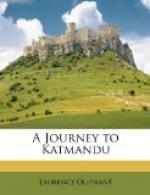So much has already been written on the interesting subject of the caves of Ajunta, that they are more or less familiar to every one, or, if not already familiar, are destined soon to become so, thanks to the skill and energy of Captain Gill, who is at present engaged in making copies of all the paintings. These will form a splendid collection, and some of them have already been sent to England, and placed in the collection at the East India House. It was doubly delightful to us, who had just previously examined the originals, to look over the portfolios of this talented draftsman.
Ere we left the village of Ajunta we visited its neat whitewashed mosque: the association connected with it must be replete with interest to the Englishman, when he calls to mind that in it the Duke of Wellington—then Sir Arthur Wellesley—wrote his despatches immediately previous and subsequent to the victory of Assaye.
The caves of Ellora are two days’ journey from those of Ajunta, and are much more cheerfully situated on the face of a hill commanding an extensive view over a more smiling country than is usually to be met with in the Deccan.
It is difficult to say which set of caves are most worth seeing; differing in many respects, they may be said to afford equal attraction to the traveller. Ellora can boast of the wonderful “Kylas;” Ajunta of those most interesting frescoes which carry the art of painting back to an unknown period, but which at Ellora have been almost totally obliterated by the ruthless and fanatical zeal of Aurungzebe.
A few miles from the caves of Ellora frowns the rock fortress of Doulatabad, a conspicuous object from every side, and we soon discovered its interior to be as singularly interesting as its exterior was formidable and imposing. The rock itself is a pyramid rising abruptly to a height of 700 feet above the village which nestles at its base, while it is scarped all round to the broad moat by which it is encircled, forming a sheer precipice of 100 or 150 feet in depth.
Passing through a massive gateway which led into the town, we entered the fort by a similar approach, and crossing the moat by a narrow bridge we plunged into a dark hole directly opposite; then passing by torchlight through some small caves which were entered by very low portals, we began to ascend the inclined plane which wound up the interior of the rock, and which gradually became steeper till it ended in a flight of steps, our guides lighting us on our uncertain path, until we emerged into daylight by a large iron trap-door, pierced with innumerable small holes, the object of which, as well as of a groove in the rock communicating with the subterranean passage, was to enable the garrison, by filling the passage with smoke and flame, to suffocate and blind the besiegers should they ever succeed by any accident in penetrating thus far—in itself, as it seemed to me, a very improbable contingency. We clambered up the face of the rock to its summit, whence we had an extensive view of the arid plains of the Deccan.




